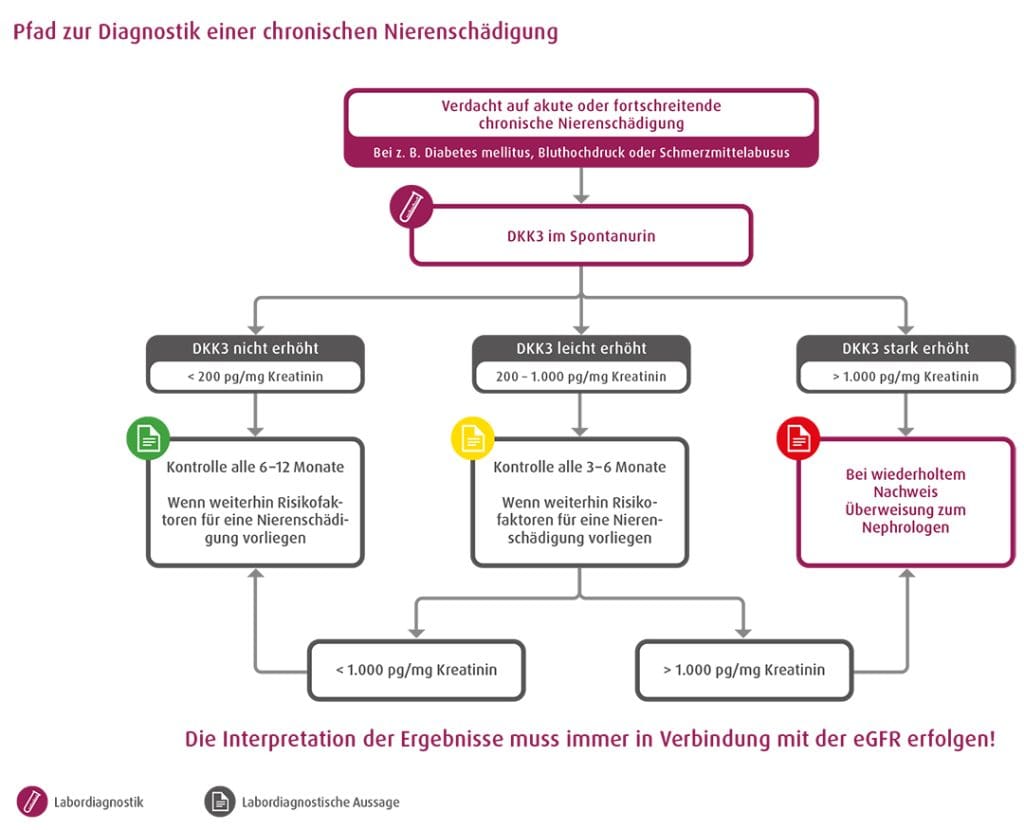DKK3 in urine: early warning system for kidney damage
Dickkopf-3 (DKK3) is an innovative biomarker that indicates incipient or progressive kidney damage even when conventional laboratory values such as serum creatinine or albumin in the urine are still unremarkable. The DKK3 value also helps to identify the individual risk of progression at an early stage and to assess the course of CKD (Chronic Kidney Disease) in a more targeted manner.
DKK3 as an early indicator in nephrology
Chronic kidney disease often develops gradually. A reduction in the glomerular filtration rate (eGFR) or albuminuria is usually only present when the structural damage is already advanced. With DKK3, a biomarker is now available that reliably maps tubular stress and provides an early indication of active kidney damage.

Biological background and laboratory diagnostics
DKK3 is produced by tubule epithelial cells under stress conditions and released into the urine. The signaling molecule is closely linked to the Wnt/╬▓-catenin signaling pathway, which is active during embryonic development. Subsequent reactivation in renal tubule cells is considered pathological.
DKK3 is determined in spontaneous urine using an IVDR-certified ELISA (ReFiNE). DKK3 is not detectable or only minimally elevated in the urine of people with healthy kidneys.
Interpretation of the values
DKK3 in urine provides clinically relevant information for risk stratification of patients with known or suspected kidney disease. The classification is based on the following threshold values:
- below 200 pg/mg creatinine: no indication of active kidney damage
- 200 to 1,000 pg/mg creatinine: incipient or discrete kidney damage possible
- Over 1,000 pg/mg creatinine: clear indication of active or progressive kidney damage
- Repeated measurement and nephrological clarification is recommended if the values are elevated.
Clinical areas of application
The DKK3 value in urine is particularly important for patients at risk. These include people with diabetes mellitus, arterial hypertension, genetic predisposition or long-term use of nephrotoxic substances such as NSAIDs or cytostatics. DKK3 can also contribute to the diagnostic classification of patients with haematuria or proteinuria of unknown cause.
Evidence from cohort studies
The suitability of DKK3 in urine for the assessment of progression has been confirmed in several studies. Prospective studies in over 1,500 adult CKD patients and children with CKD showed that an elevated DKK3 value correlates with a significant loss of eGFR within the next 6-12 months. It was particularly striking that this correlation also existed in patients without relevant albuminuria.
In the STOP-IgAN study, DKK3 was not only used to estimate the risk of a deterioration in kidney function. It was also possible to predict the individual response to immunosuppressive therapy.
Use in acute kidney damage
DKK3 in urine is also relevant in the assessment of acute kidney injury. In a study with cardiac surgery patients, it was shown that an elevated preoperative DKK3 value indicates a greatly increased risk of progressive postoperative renal failure (AKI-CKD transition). In contrast, patients with low DKK3 values in the urine hardly developed any renal complications.
Conclusion
DKK3 in urine adds a pathophysiologically based component to the established diagnostics of chronic kidney disease. The marker provides early indications of progressive damage and can contribute to improved patient selection, therapy monitoring and preoperative risk assessment. DKK3 in urine thus represents a practical instrument for the implementation of nephrological precision medicine.
For further information, please contact us directly: nephrologie@limbachgruppe.com
The respective companies are responsible for the content of the “Corporate News” section



